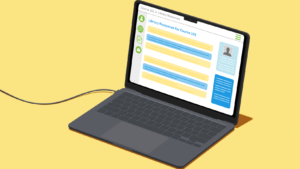In today’s digital age, media literacy is an essential skill for students, especially when researching historical events or navigating current news. Eighth-grade students can benefit from a collaborative approach to media literacy, with history teachers and the school librarian teaming up to deliver a powerful two-day lesson. The goal? To help students learn how to validate sources and recognize media bias, skills that are critical for success in both academics and daily life.
This collaborative lesson plan is designed to integrate the school library’s resources into the history curriculum, showing students how to critically analyze information and become savvy consumers of media. By combining their expertise, history teachers and the librarian can teach students not only to evaluate the credibility of sources but also to recognize how media bias can shape their understanding of historical events.
Day 1: Understanding Media Literacy and Validating Resources
The first day focuses on teaching students the fundamentals of media literacy and how to validate resources. The lesson kicks off with a quick warm-up activity: students are shown two headlines—one from a credible source and another from a less reliable one—and asked to guess which is more trustworthy. This sparks a conversation about why it’s important to critically assess the sources they encounter, especially when researching for school projects.
From there, the school librarian steps in to deliver a mini-lesson on validating resources. Students are introduced to the school’s digital databases, academic journals, and archives, where they can find credible information for their history research. The librarian walks them through an Evaluating Sources Checklist, a tool they’ll use throughout the lesson to assess the reliability of articles and sources. The checklist prompts students to consider factors such as:
- Author credentials
- Publisher credibility
- Supporting evidence (such as citations or links to reliable sources)
- Publication date
Students are then broken into groups, where they receive two articles on the same historical event—one from a credible source and one from a questionable one. Using the checklist, students work together to evaluate the credibility of each article. This activity not only teaches students how to identify trustworthy sources but also emphasizes the importance of cross-referencing information, a skill that will serve them well in future research.
The librarian also introduces students to fact-checking websites like Snopes and FactCheck.org, demonstrating how these tools can be used to verify claims in articles. This skill becomes increasingly relevant as students are tasked with a homework assignment: finding an article on a historical or current event and validating its credibility using the checklist. The next day, they’ll present their findings to the class.
Day 2: Recognizing and Analyzing Media Bias
On the second day of the lesson, students dive deeper into media literacy by learning how to identify bias in the sources they read. After reviewing their homework, the history teacher introduces the concept of media bias, explaining how it can affect the way information is presented. From sensationalism to partisanship, bias comes in many forms, and it’s crucial that students learn to spot it in their sources.
The school librarian then leads another mini-lesson, this time focusing on how to recognize bias in both historical sources and current media. The librarian highlights tools and resources available through the library that can help students cross-check information and assess for bias. Students learn how word choice, the selection of facts, and the representation of different viewpoints can signal bias in a text.
Next, students are divided into groups and given two articles covering the same historical event but from different perspectives. Their task is to analyze each article for bias, using a digital whiteboard or sticky notes to track examples of:
- Language or tone that indicates bias
- Whether the article presents facts or opinions
- How different viewpoints are represented
This activity helps students see firsthand how bias can influence the way historical events are portrayed. After discussing their findings with the class and the librarian, the students engage in a broader conversation about the importance of recognizing bias in research. They consider how biased sources can distort their understanding of history and why it’s crucial to use reliable, unbiased resources for school projects.
To wrap up the lesson, students complete an exit ticket, reflecting on how they will apply what they’ve learned about media bias and source validation in their future research. The history teacher and librarian encourage students to continue using the library’s resources and databases for their projects, ensuring that they leave the lesson equipped with the skills they need to navigate today’s information-rich world.
A Collaborative Approach to Media Literacy
This collaborative lesson between the history teacher and the school librarian showcases the power of partnership in education. By working together, they help students develop critical thinking skills and navigate the complexities of media and information. From validating sources to analyzing media bias, students leave the lesson better prepared to approach their history research—and the media they consume in their daily lives—with a discerning eye.
This collaboration highlights the importance of integrating library resources into the curriculum, providing students with hands-on experience in media literacy that extends beyond the classroom. As they move forward in their academic journeys, these eighth graders will carry with them the ability to think critically about the information they encounter, both in their history classes and beyond.
Edstablished, created by educator and digital media expert Taylor Jennings, shares insights on education, technology, and libraries. With a focus on EdTech, digital citizenship, and instructional design, Edstablished supports educators in creating engaging learning experiences.






No comment yet, add your voice below!